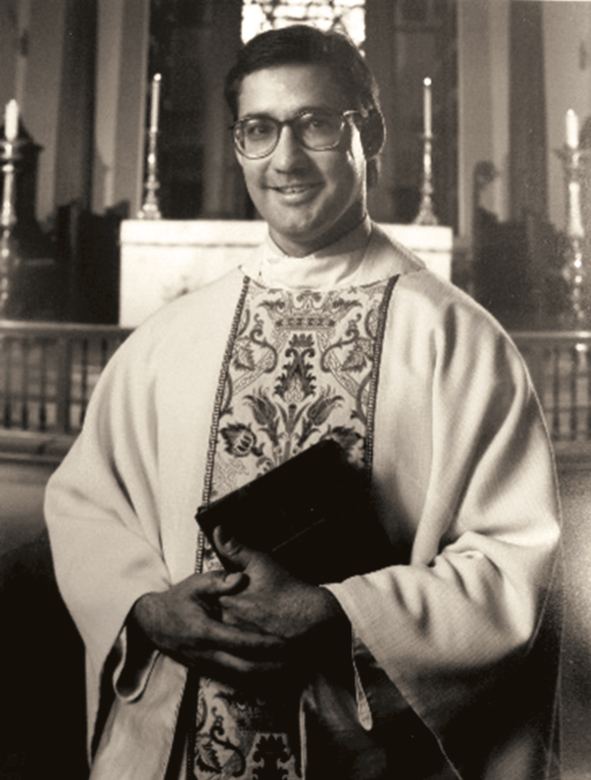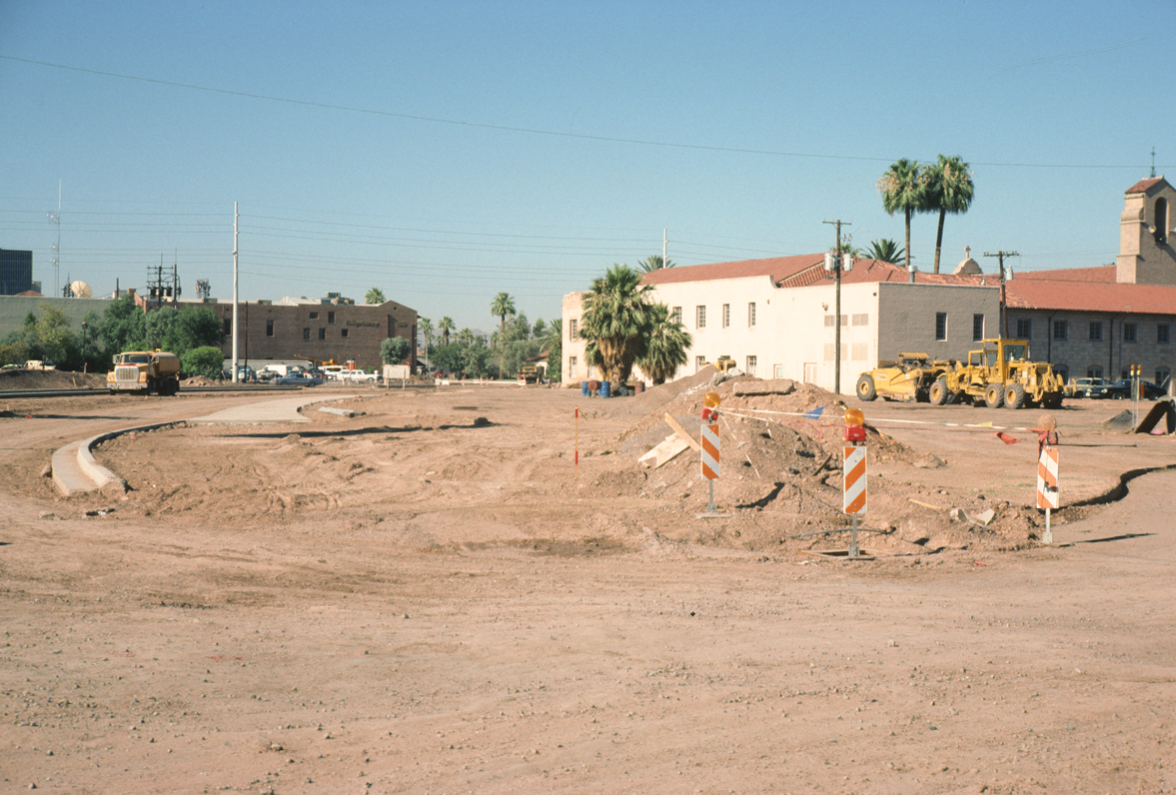Centennial Timeline
Timeline Color Key | Trinity Cathedral (Blue) | City of Phoenix, AZ (Brown)
Before 1900 | 1900-20 | 1920-40 | 1940-60 | 1960-80 | 1980-00 | 2000-20 | 2020-40 & Beyond
1980-00
1980 February
Salt River floods, washing away most of the bridges spanning it.
1980s
Thanksgiving and Christmas Day breakfast served to the homeless community, a tradition that has continued ever since.
1981
The Arizona State University west campus, in Phoenix near Glendale, is established.
1981
The AIDS epidemic begins.
1985
Bishop Wesley Frensdorff of Nevada becomes the Assisting Bishop to Bishop Heistand. He creates new models of ministry to energize diocesan members into a collective model of service. Sadly, he dies in an airplane crash in the Grand Canyon in 1988.
Photo: Assisting Bishop Wesley Frensdorff, 1985-1988

1980s
The Bishop’s House served the homeless through the auspices of what would become the Ecumenical Chaplaincy for the Homeless led by Gerald Roseberry, former Presbyterian minister and current member of the Cathedral.
1981, January
North Phoenix Corporate Ministries (now Nourish Phoenix) begins operating at Trinity Cathedral before moving to a new location in 1983.
1983, November
The historical significance of the Roosevelt neighborhood is officially recognized by the National Register of Historic Places. The State of Arizona has further recognized the neighborhood by establishing Historic Preservation Overlay Zoning in 1986.
By 1985
Dean Usher explores ways to remodel the Cathedral for a smaller congregation in a changing environment during a period of social and political upheaval, and to create a funding stream through the installation of a columbarium.
1986
City urban village divisions are created: Ahwatukee Foothills, Alhambra, Camelback East, Central City, Deer Valley, Desert View, Encanto, Estrella, Laveen, Maryvale, North Gateway, North Mountain, Paradise Valley, Rio Vista, and South Mountain.
1987
Bishop Heistand addresses the inability of Trinity Cathedral to pay the costs of its operation and its annual assessment to the Diocese.
1987
Dean Usher is asked to resign.
1987
A newly ordained clergy, the Rev Timothy Kazan of Page, Arizona, is appointed Canon Pastor/Priest-in-Charge of Trinity Cathedral. He ministers to elders committed to keeping the Cathedral open and young activists aiming to make a difference in the world. He serves until 1991. In 1994 he and his wife are both killed in a traffic accident.
Photo: The Reverend Timothy Kazan, Pastor-in-Charge, 1987-1991. Upon graduation from seminary he received the Armen Jorjorian Award for his efforts to relate the Gospel to social justice concerns.

1988
The Deanery becomes Diocesan Offices for Bishop and Diocesan staff.
1988
Trinity Cathedral loses parish status and is designated Diocesan Cathedral. This action taken by Bishop Heistand establishes Trinity as a “true” Cathedral in the traditions of the Church of England where the Bishop and a Chapter (instead of a Vestry) are responsible for the operation of the Diocesan Cathedral. Trinity becomes the fourth such cathedral in the United States, joining Grace Cathedral in San Francisco, The Cathedral of St. John the Divine in New York, and the National Cathedral in the District of Columbia.
1988
Deacon William Jamieson is assigned to the Cathedral to support members who remained during this period of social and political upheaval.
Late 1980s-early 1990s
Artists see opportunity where others saw blight and create studios in abandoned buildings, planting the seeds for the future Roosevelt Row.
1990
The final mile of Papago Freeway (I-10) under Central Avenue is completed. This project would complete the I-10 corridor from California to Florida. Mayor Margaret T. Hance, a Cathedral member, is influential in this project’s completion.
Photo: The Papago Freeway (I-10), looking east, as built, Phoenix, 1991. Courtesy of Arizona Department of Transportation.

1990-2000
Downtown Phoenix begins a rebirth with new sports and cultural venues in the City’s center, new office buildings, bank buildings, a Light Rail system, and apartment and condominium complexes.
1990
Presiding Bishop of the Episcopal Church, Edmund Browning, joins the march in Arizona for the Martin Luther King national holiday.
1990s
Cathedral Congregational growth begins.
1990s
Cathedral Arts and music ministries draw people who are moving back to the city’s core.
1991
In partnership with members of the Phoenix Firefighter’s Union, Trinity creates a school room in Bishop Atwood House for young children experiencing homelessness. The school later becomes the Thomas J. Pappas School.
1991
The Rev. Richard M. George becomes Ninth Dean of Trinity Cathedral.
Photo: Dean Richard M. George, 1991-1994.

1990s
Dean George oversees remodeling of Atwood House’s second floor, creating space for office and meeting space.
1991
The Rev. David Keller takes up residence and is charged with the Bishop’s School, which provides support in hosting the General Convention and focuses on the spiritual development of God’s people through such mechanisms as Education for Ministry (EfM).
1991, July
The Diocese of Arizona hosts the 70th General Convention of the Episcopal Church in Phoenix’s Civic Center. Organist and Choir Director James Clapp assembles a choir from churches throughout the Diocese to sing at services held at the Cathedral during the convention. This Choir completesd its service by providing a public concert of Faure’s Requiem.
1992
The people of Arizona vote and pass Proposition 300, making Arizona the last state to ratify Martin Luther King Day.
1992
The Rev. Robert M. Shahan is elected as Fourth Bishop of the Diocese of Arizona. During his term he encourages Diocesan meetings and events at the Cathedral, a visible sign of his vision of We Are One as the people of God.
Photo: Bishop Robert M. Shahan, 1992-2004.

1990s
Phoenix uses Historical Preservation funds to restore the Bishop’s House, a National Historic Site. Bishop and Mrs. Shahan move into the restored home.
1993
Veronica Ritson, a Cathedral member since 1977, is ordained a Deacon and Archdeacon by Bishop Shahan. Her servant ministry is in HIV/AIDS advocacy and support within the Church and community. She is the first lay person from Trinity Cathedral to be raised to the diaconate. As Archdeacon, she administers the Deacon’s Formation Academy, a new program initiated by Bishop Shahan to expand the Diaconate within the Diocese of Arizona.
1994
The first ever First Friday art walk takes place, and the very first inklings of urban revitalization in historic neighborhoods like Roosevelt begins.
1994
The Rev. Jessica Hatch is appointed Tenth Dean of Trinity Cathedral after the retirement of Dean George. Under her leadership the Cathedral begins reviewing the past and envisioning the future. She hires Alan DePuy, a young organist who moved to Arizona to pursue an organ performance degree at Arizona State University with Dr. Robert Brown, as organist and choirmaster, She resigns in October 1995.
Photo: Dean Jessica Hatch, 1994-1995.

1995
Phoenix’ Burton Barr Library, across from the Margart T. Hance Park, opens.
1995
Deacon Ritson, parishioner Jonathan Runyan, and Dean Hatch present panels on behalf of Trinity Cathedral for the traveling AIDS Memorial Quilt, on display at Phoenix Civic Plaza. Trinity adopts a major outreach program in support of victims of the AIDS epidemic.
1995
The Rev. Rebecca L. McClain is appointed Eleventh Dean of Trinity Cathedral and Canon to the Ordinary. Her vision for the Cathedral is centered around three pillars: Simple and elegant Anglican worship, engagement at the margins in social outreach, and cultivation of the arts in the downtown core.
Photo: Dean Rebecca McClain, 1995-2005.

1990s
Avery Olney, long-time congregational member and usher, donates funds for remodeling of Cathedral House in memory of his beloved wife, Gladys.
1995-2005
Rebecca McClain facilitates the sale of Trinity-owned land on West Roosevelt Street and Portland Parkway adjacent to the Cathedral to the Post Properties company. The land is redeveloped into a neighborhood filled with urban housing and amenities and including access to the north side of Cathedral House and parking facilities for Cathedral members. A companion congregational capital campaign, The Restoration of a Holy Space, is initiated to restore the nave to its full proportions. The vision of We Are One – A Place of Radical Hospitality emerges.
Photo 1: The north side of the Cathedral campus before redevelopment.
Photo 2: Looking at the Cathedral campus from the north and east.
Photo 3: The east side of Bishop Atwood House.
Photo 4: The Cathedral Close from the south.
Photo 5: The parking lot behind the Cathedral campus, from the north.





1996
Canon Alan DePuy launches a seasonal concert series with Mozart’s Requiem.
1996
The Japanese Friendship Garden installation next to Margaret Hance Park and near Trinity Cathedral is completed.
1997
A new organ is purchased from an installation in Claremont, California. Trinity’s installation is begun by the Schantz Organ Company of Oreville, Ohio.
1997
The Phoenix Bach Choir (Phoenix Chorale) is welcomed into the Cathedral fold, gaining office and performance space.
1997
Deacon Ritson and Dean McClain launch the Arizona Diocese Deacon Formation Academy.
1997-1999
The Cathedral Center for the Arts, an incubator and umbrella to emerging arts groups, is formed. By 2000 it establishesd a working relationship with Rosie’s House, a free music academy for inner city children. In 2001 the Cathedral Center for the Arts is established as a 501c3 non-profit organization, and in 2006 is dissolved.
1997-1999
Congregational development and faith formation opportunities flourish: Godly Play (for young children), Education for Ministry (with Keith Cook and Warren Adams), The Resident Aliens (poetry and spiritual development with Dean McClain), The Urban Monastics (spiritual growth and service with Dean McClain and Deacon Ritson), Sunday morning adult education led by a multitude of facilitators and speakers, and Tea with the Dean for newcomers.
1998
The late Senator Barry Goldwater lies in repose in the Cathedral. In two days of visitation 7000 people come to honor his life and service. On June 7, 1998, his burial service is conducted for the family.
Photo 1: A steady flow of people lines up to view the casket of former U.S. Sen. Barry Goldwater during a public visitation at Trinity Cathedral in downtown Phoenix on June 2, 1998. Tim Koors/The Republic.
Photo 2: An Air Force honor guard carries the casket of former U.S. Sen. Barry Goldwater into the Trinity Cathedral in downtown Phoenix June 2, 1998, followed by the Rev. Rebecca McClain. Jeff Robbins/Associated Press


1999
Bishop Shahan issues a pastoral letter in response to the 1998 Lambeth Conference, which had condemned homosexual relationships. Bishop Shahan’s letter affirms that all of God’s children are loved and welcome at the table and in the Diocese of Arizona. The Lambeth Conference is an international meeting of bishops in the Anglican Communion, of with the Episcopal Church is a part.
1999
The Irish Cultural Center opens just north of Trinity Cathedral next to Margaret T. Hance Park.
1999, December 23
The celebration of Bishop Joe Harte’s life takes place at Trinity Cathedral.

